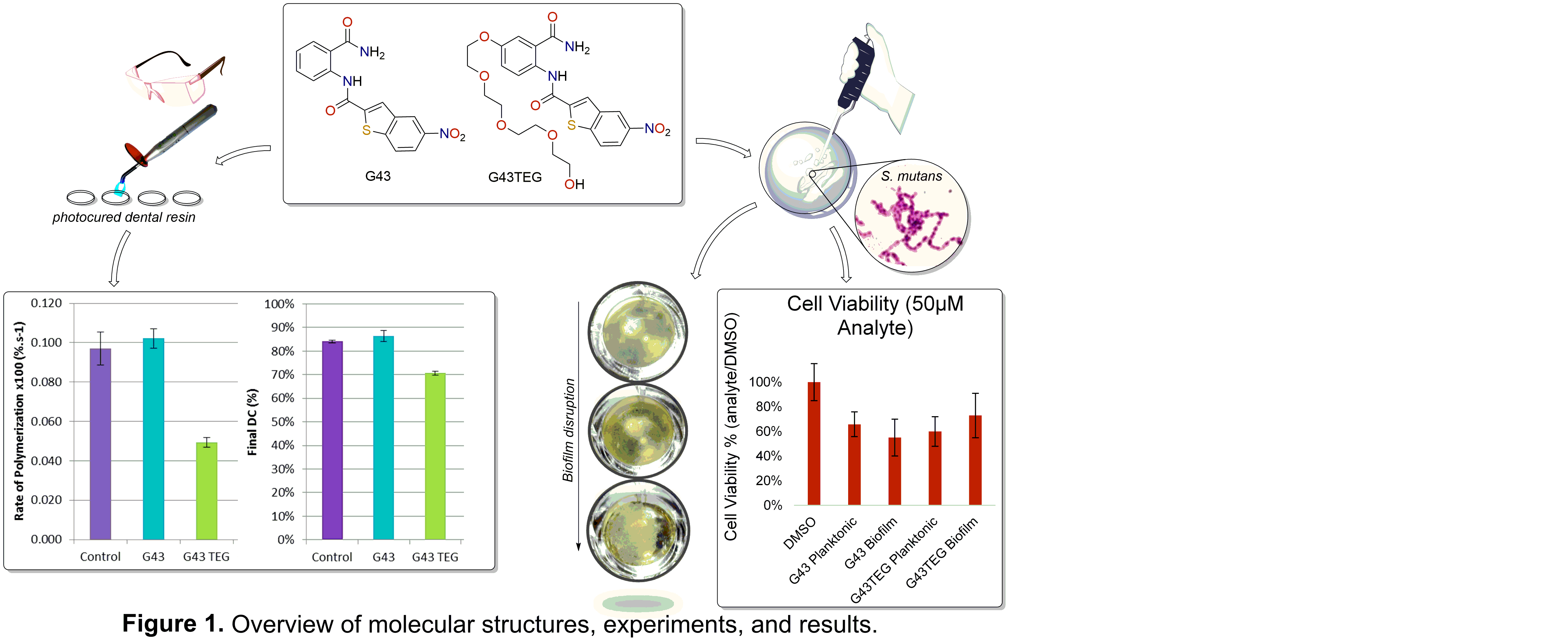IADR Abstract Archives
Bioactive Polymers for S. mutans Biofilm Inhibition
Objectives: The development of biofilms on dental restorations may lead to the formation of secondary caries. The purpose of this study was to determine the efficacy of bioactive small molecules (G43 & G43TEG) to disrupt/inhibit biofilm formation of bacterial species contributing to caries causing biofilm dysbiosis.
Methods: First, G43 and G43TEG were synthesized and minimum inhibitory concentration (MIC) against S. mutans were established. The compounds were dissolved in DMSO and serially diluted in H2O to 400, 200, 100, 50, 25 and 12.5 µM, then added to S. mutans cultures (TH medium with sucrose) & incubated for 96 h at 37°C aerobically. Supernatants with planktonic cells and biofilms were assayed separately (metabolic activity via S. mutans carrying a renilla luciferase reporter). Next, G43 or G43TEG were tested for material properties (4 wt% into 50:50 BisGMA/TEGDMA and 70 wt% filler, 0.2 wt% BAPO photoinitiator, & 0.05 wt% BHT inhibitor). Polymerization kinetics were assessed for 5 min by near-IR (4 mm by 10 mm diameter discs), cured via 400–500 nm LED (700 mW/cm2, 30 s). Discs were then immersed in deionized H2O for 7 days, with extracted monomers collected every 24 h. Results were analyzed with one-way ANOVA/Tukey’s test (α=0.05).
Results: The MIC was determined to be 25-50µM for both G43 and G43TEG a slight reduction of viable biofilm cells (Fig. 1) with a visual disruption of the biofilm. Polymerizations of dental resins were slightly affected by 4% G43 or G43TEG (Fig. 1), however cured ≥70% DC for both cases. Analysis of leachates showed no detectible G43 or G43TEG (<11 µM).
Conclusions: This study demonstrated that bioactive molecules in the G43 family affect S. mutans biofilm viability (25-50 µM). Further, G43 and G43TEG were tolerable for polymerization kinetics, retaining relatively high final DCs.
Methods: First, G43 and G43TEG were synthesized and minimum inhibitory concentration (MIC) against S. mutans were established. The compounds were dissolved in DMSO and serially diluted in H2O to 400, 200, 100, 50, 25 and 12.5 µM, then added to S. mutans cultures (TH medium with sucrose) & incubated for 96 h at 37°C aerobically. Supernatants with planktonic cells and biofilms were assayed separately (metabolic activity via S. mutans carrying a renilla luciferase reporter). Next, G43 or G43TEG were tested for material properties (4 wt% into 50:50 BisGMA/TEGDMA and 70 wt% filler, 0.2 wt% BAPO photoinitiator, & 0.05 wt% BHT inhibitor). Polymerization kinetics were assessed for 5 min by near-IR (4 mm by 10 mm diameter discs), cured via 400–500 nm LED (700 mW/cm2, 30 s). Discs were then immersed in deionized H2O for 7 days, with extracted monomers collected every 24 h. Results were analyzed with one-way ANOVA/Tukey’s test (α=0.05).
Results: The MIC was determined to be 25-50µM for both G43 and G43TEG a slight reduction of viable biofilm cells (Fig. 1) with a visual disruption of the biofilm. Polymerizations of dental resins were slightly affected by 4% G43 or G43TEG (Fig. 1), however cured ≥70% DC for both cases. Analysis of leachates showed no detectible G43 or G43TEG (<11 µM).
Conclusions: This study demonstrated that bioactive molecules in the G43 family affect S. mutans biofilm viability (25-50 µM). Further, G43 and G43TEG were tolerable for polymerization kinetics, retaining relatively high final DCs.

